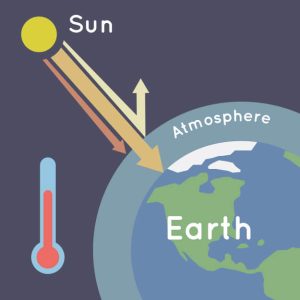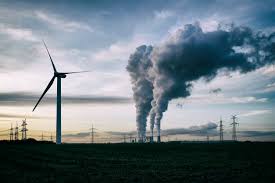Greenhouse Effect
This effect occurs when gases in Earth’s atmosphere trap the Sun’s heat, makes Earth much warmer than it would be without an atmosphere. The greenhouse effect is one of the things that keep life on the earth or make earth livable.
What is Greenhouse?
A greenhouse is a building with glass walls and a glass roof which are used to grow plants, such as tomatoes and tropical flowers.
In the daytime, sunlight enters the greenhouse and warms the plants and air inside. At nighttime, it’s colder outside, but the greenhouse stays pretty warm inside. That’s because the glass walls of the greenhouse trap the Sun’s heat. A greenhouse stays warm inside, even during the winter. Otherwise, surface temperature would be cooler by about 330C.

Effect on Earth
The greenhouse effect works much the same way on Earth. Gases in the atmosphere, such as carbon dioxide, trap heat similar to the glass roof of a greenhouse. These heat-trapping gases are called greenhouse gases.
During the day, the Sun shines through the atmosphere; as a result, Earth’s surface warms up in the sunlight. At night, Earth’s surface cools, releasing heat back into the air. But some of the heat is trapped by the greenhouse gases in the atmosphere. That’s what keeps our Earth warm.
What are Greenhouse Gases?
Earth’s greenhouse gases trap heat in the atmosphere and warm the earth planet. The main gases responsible for the greenhouse effect include carbon dioxide, methane, nitrous oxide, and water vapor.
In addition to these natural compounds, synthetic fluorinated gases known as chlorofluorocarbons (CFCs) also function as greenhouse gases. Different greenhouse gases have different chemical properties and are removed from the atmosphere, over time, by various processes. Carbon dioxide, for example, is absorbed by forests, soil, and the ocean. Fluorinated gases are only destroyed by sunlight in the far upper atmosphere.
How much any one greenhouse gas influences global warming depends on three key factors:
- How much of the gas exists in the atmosphere.
- How long the gas remains in the atmosphere,
- How effective the gas is at trapping heat.
Do Humans Impact the Greenhouse effect?
Yes. Various activities of humans are changing Earth’s natural greenhouse effect. For instance, burning fossil fuels like coal and oil puts more carbon dioxide into our atmosphere. Cars, trucks, trains, planes and electric power plants all burn fossil fuels. Deforestation is another factor.

Most methane in the atmosphere comes from livestock farming, landfills, and fossil fuel production such as coal mining and natural gas processing. Nitrous oxide comes from agricultural technology and fossil fuel burning.
Fluorinated gases include chlorofluorocarbons, hydro-chlorofluorocarbons, and hydro-fluorocarbons. These greenhouse gases are used in aerosol cans and refrigeration.
All of these human activities add greenhouse gases to the atmosphere, trapping more heat than usual and contributing to global warming.
Too much greenhouse gases can cause Earth’s atmosphere to trap more and more heat which causes our Earth warm.
What can Reduces the Greenhouse effect on Earth?
Earth’s greenhouse is also full of plants that can help to balance the greenhouse effect on Earth. Because all plants take in carbon dioxide and give off oxygen.
The ocean also absorbs a lot of excess carbon dioxide in the air. Unfortunately, the increased carbon dioxide in the ocean changes the water, making it more acidic what we call ocean acidification.
More acidic water can be harmful to many ocean creatures. Warmer waters are a main cause of coral bleaching.
Some steps by which we can reduce the effect:
- By reducing greenhouse gases emissions.
- By improving energy efficiency in home and businesses, and by improving fuel efficiency in vehicles.
- Using alternative sources of energy like solar power and biofuels.
- Carbon sequestration.
- By changing farming practices like reducing chemical fertilizers.